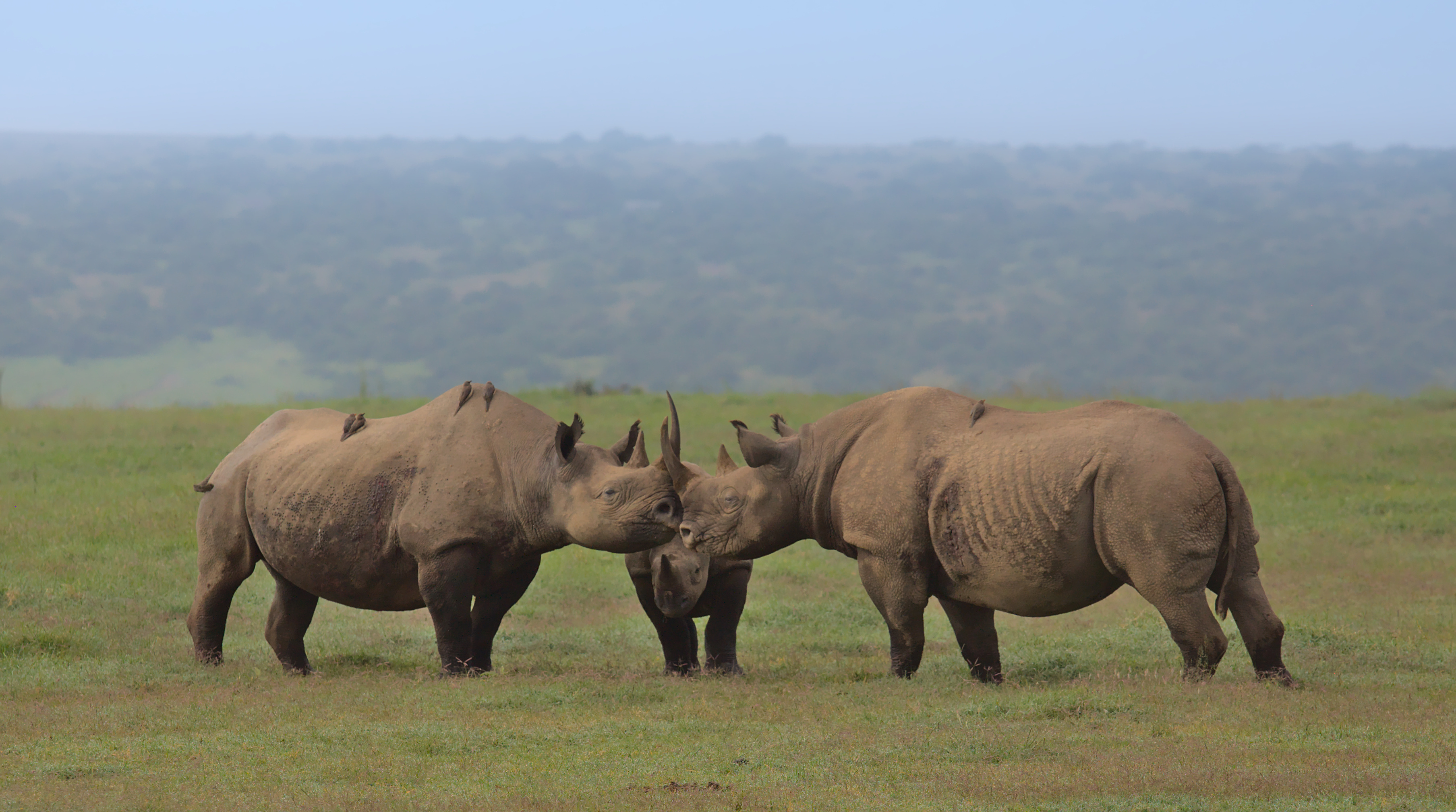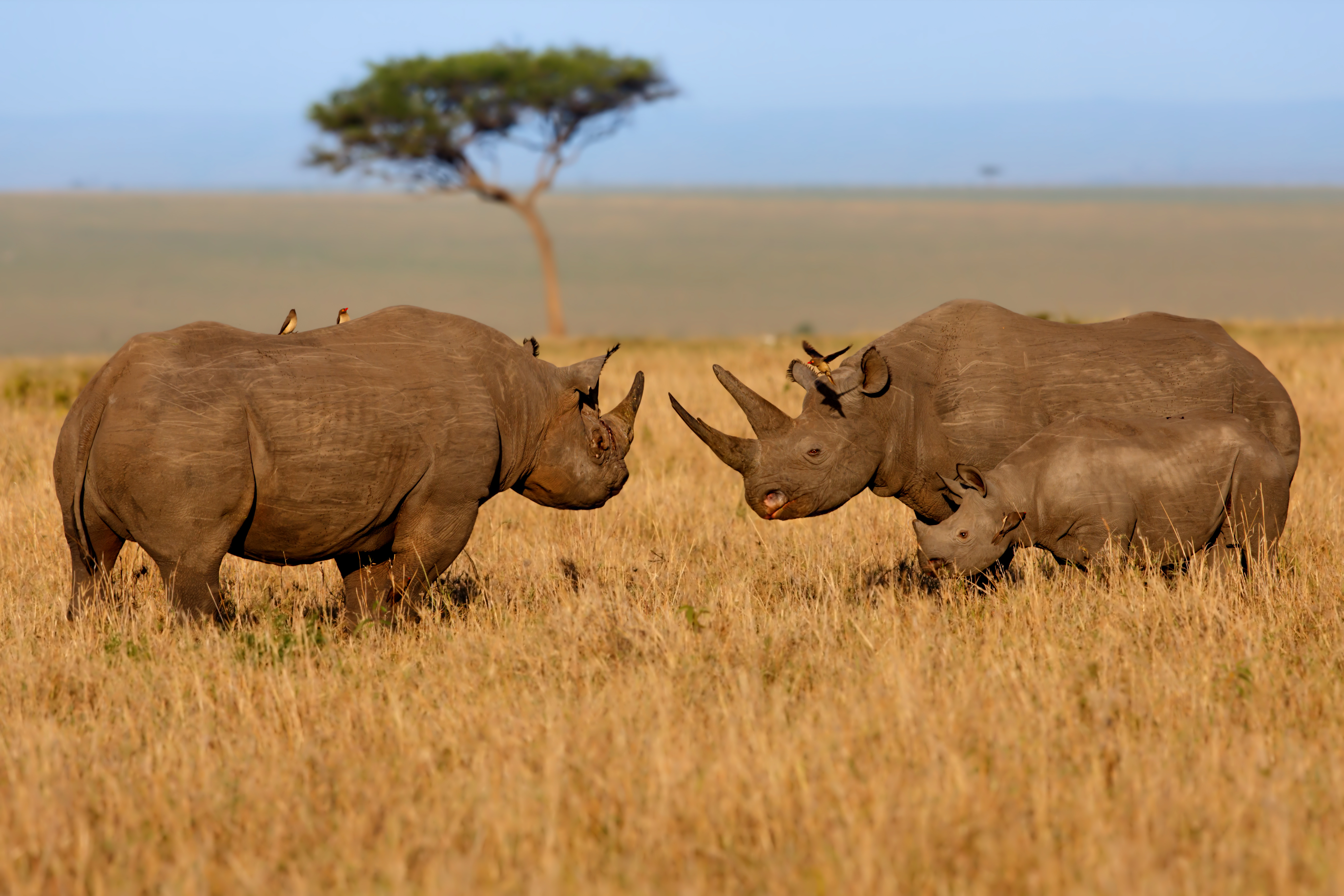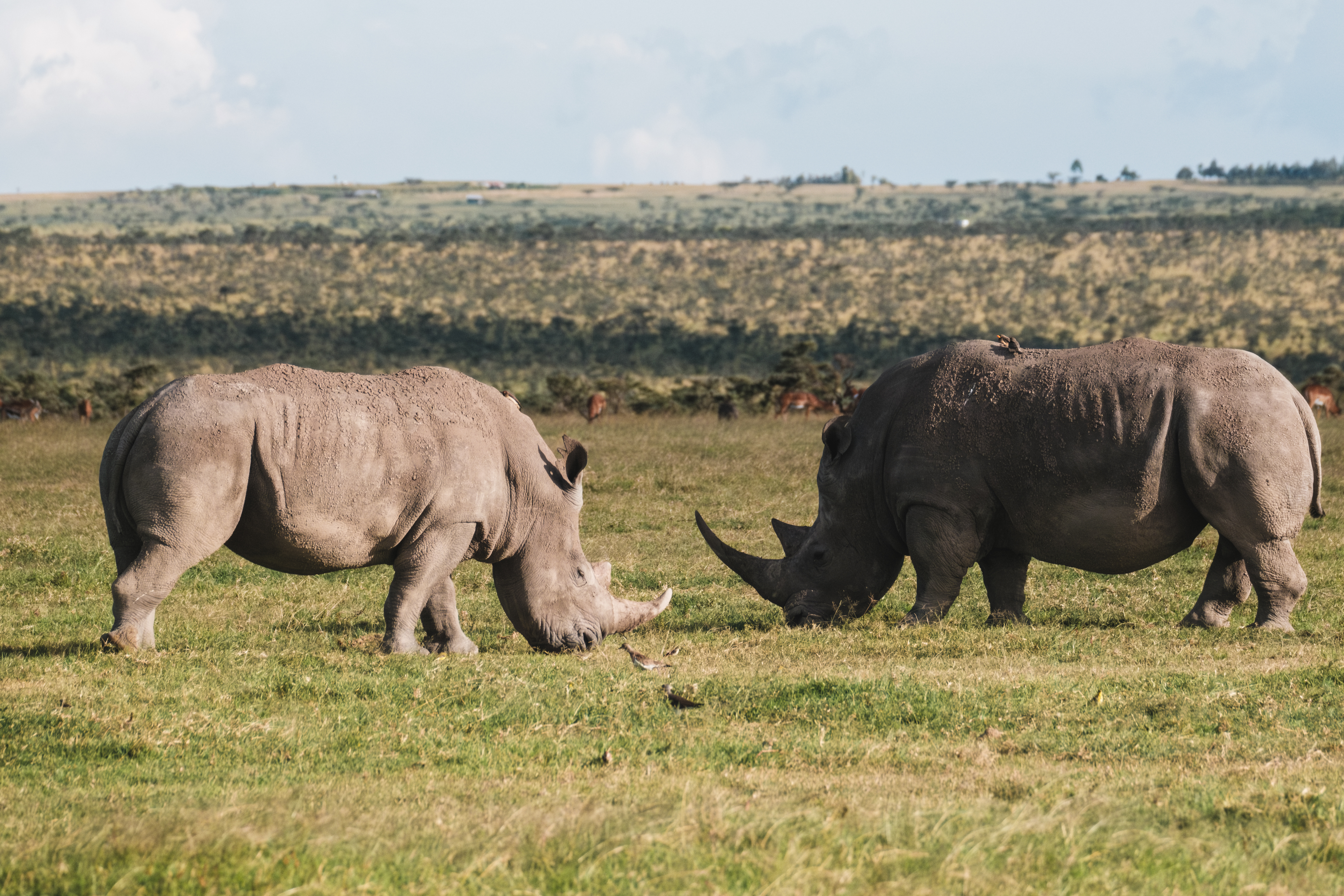Securing Kenya’s Black Rhinos: Debunking Kenya's Largest Rhino Notching Exercise.

A crash of black rhinos gathering with their horns touching in the wild plains of Solio game reserve, Kenya
Kenya has launched its largest-ever black rhino ear‑notching and tagging operation in Ngulia Rhino Sanctuary in Tsavo West National Park. For a country whose rhinos crashed from tens of thousands in the 1970s to fewer than 400 animals at the height of poaching, today’s recovery to over 1,000 eastern black rhinos is a hard‑won success story that still needs careful stewardship.
African Wildlife Foundation (AWF) has walked this journey with Kenya Wildlife Service (KWS) and other partners for decades. We spoke with Dr Philip Muruthi, African Wildlife Foundaton’s Vice President, Species Conservation and Science and member of Kenya’s National Rhino Management Committee, about why this notching exercise matters for Kenya and for Africa‑led rhino conservation.
Q: Kenya has just launched its largest-ever black rhino ear‑notching and tagging operation in Ngulia Rhino Sanctuary, Tsavo West. From your vantage point in Kenya’s rhino conservation story, why is this particular exercise so significant?
Dr. Muruthi: If you only look at the last three decades, moving from fewer than 400 black rhinos to over 1,000 feels like a major success. But if you remember that Kenya had more than 20,000 rhinos in the 1970s, you realise we are still in recovery mode. This large‑scale notching is about securing that recovery.
By giving every rhino in Ngulia a clear identity, we can manage the population scientifically: monitor individuals, mix genetics wisely and move animals as sanctuaries fill up. It is a critical step in delivering Kenya’s long‑term vision of growing a healthy, connected black rhino population, rather than just celebrating numbers in one site.

Field with western black rhinoceros and a baby in Lewa Wildlife Conservancy, Kenya.
Q: For a lay audience, what exactly happens during a rhino notching operation and how do these steps improve day‑to‑day monitoring and security for rhinos?
Dr. Muruthi: The team starts with a list of young or un‑notched rhinos they need to find and where they usually range. Rangers track those animals, and wildlife vets then dart them from a helicopter, vehicle or on foot, always in safe terrain and good weather.
Once the rhino is down, the vets move in quickly: they check breathing, cut a small, coded pattern in the ears, fit a VHF or GPS transmitter where required, take samples and basic measurements, then reverse the drug and stay with the animal until it is fully recovered. That ear pattern and, in some cases, telemetry turn a “rhino somewhere in the sanctuary” into a known individual whose health, movements and security can be tracked every day.
Q: Kenya’s black rhino population has rebounded from below 400 in the early 1990s to over 1,000 individuals today. How does large‑scale ear‑notching help sustain that recovery and reduce the risk of backsliding due to poaching or habitat pressures?
Dr. Muruthi: When poaching was at its worst, Kenya was left with tiny pockets of rhinos scattered across the country. The response was to bring these remnants into fenced sanctuaries where they could be protected and managed more intensively.
Ear‑notching is what allows us to treat all these sanctuaries as one national meta‑population instead of isolated fragments. We know the origin, age, sex and breeding history of each animal, so we can move rhinos before sanctuaries reach carrying capacity, avoid inbreeding and target security patrols where they are most needed. It is the foundation for evidence‑based rhino management.

Black Rhino Family at sunrise in Masai Mara, Kenya
Q: In your role on Kenya’s National Rhino Management Committee, how does this notching drive fit within the country’s rhino action plan and its long‑term vision for rhino range, genetics and population growth?
Dr. Muruthi: Ngulia’s notching operation is not a stand‑alone event. It is written into Kenya’s National Rhino Strategy and Implementation Plan, which spell out the growth rates we want to achieve, the target number of black rhinos, and the need to expand range through new sanctuaries and intensive protection zones.
You cannot make those decisions blindly. Individual identification and tagging give managers the data they need to decide which animals to move, where to start new populations and how to keep each sub‑population within its ecological limits while still growing the overall national herd.
Q: What kinds of data do you and your partners gain from notched and tagged rhinos — for example, movement patterns, habitat use or social behaviour — and how does that information translate into concrete conservation decisions on the ground?
Dr. Muruthi: From the notch code alone, we know an animal’s identity, sex, approximate age and origin. Daily monitoring then builds a picture of its home range, calving history, survival and interactions with other rhinos. Where we add GPS or VHF transmitters, we get even finer detail on movement and how rhinos respond to changes like new water points, fire or drought.
All of that feeds into very practical questions: is a sanctuary nearing its biological carrying capacity? Which animals are best suited to found a new population? Are there security hotspots that require more patrols? Good data is what turns rhino conservation from guesswork into adaptive management.
Q: Rhino operations are risky, expensive and logistically complex. What does it take in terms of funding, veterinary expertise, aircraft, rangers and community support to safely notch and tag more than 100 rhinos in just a couple of weeks?
Dr. Muruthi: It takes a small army of specialists working as one team. You need experienced wildlife vets and pilots, skilled rangers who know every corner of the sanctuary, ground crews, security teams and trackers. Then there are the less visible costs: helicopter hours, immobilisation drugs, vehicles, equipment, fuel and the follow‑up monitoring that continues long after the last rhino is notched.
This is why partnership is so important. KWS leads the operation, but organisations like AWF and other conservation and private‑sector partners typically contribute funding, training, equipment and sometimes aircraft. Communities living around sanctuaries are also key allies in sharing information and supporting protection efforts.

Pair of black rhinos grazing peacefully in Ol Pejeta Conservancy.
Q: From an animal‑welfare and ethics perspective, how do you balance the invasive nature of ear‑notching with the long‑term benefits for rhino survival? What safeguards do teams put in place to minimise stress and mortality during these operations?
Dr. Muruthi: We are dealing with critically endangered animals, so every operation has to minimise risk. There are strict protocols on when, where and which animals to dart. Vets avoid darting near cliffs, water bodies or in heavy rain, and they do not target obviously pregnant females or animals in difficult terrain.
Once the procedure is done, the team stays with the rhino through recovery to ensure it gets up safely and does not walk straight into danger, such as a nearby predator. The brief discomfort of notching is weighed against the long‑term benefits of better protection, healthier populations and a stronger chance of the species’ survival.
Q: Where does AWF plug into exercises like the Tsavo operation and how does that complement work by other partners?
Dr. Muruthi: First, AWF is part of the National Rhino Management Technical Committee, so we help design the strategies and action plans that guide operations like the Ngulia notching drive. We know this is not an ad‑hoc exercise; it is part of a long‑term recovery roadmap.
Second, we provide financial and technical support. AWF has supported the rhino programme in Tsavo since the mid‑1980s, including investing in ranger housing, equipment and other infrastructure in the intensive protection zones. Because we also work on rhinos in other African countries, we are able to share lessons and expertise across borders.
Q: What role do neighbouring communities play in making a notching exercise successful — both in terms of information sharing and building long‑term buy‑in for rhino protection as part of their own development?
Dr. Muruthi: During the actual notching, community members cannot be close to the operation for safety and to reduce stress on the animals — it is not a spectacle. But over the long term, local communities are among the most important partners for rhino conservation.
In Kenya, we have seen rhinos thrive not only in state and private sanctuaries but also in landscapes anchored by community conservancies. When people see tangible benefits from wildlife they are more likely to support rhino protection, share information about threats and defend rhinos as part of their own development story.
Q: Looking beyond Kenya, what lessons from this large‑scale notching effort are most relevant for other African countries trying to rebuild rhino populations and strengthen intelligence‑led protection?
Dr. Muruthi: One key lesson is that you must know your rhinos. Individual identification and good records allow countries to manage scattered rhino groups as a single meta‑population, move animals strategically and make informed decisions about genetics and security.
Another lesson is the value of broad partnerships. In Kenya, government, private landowners, NGOs and communities all play a role. Private sanctuaries and conservancies now hold a significant share of the national herd, while community conservancies in northern Kenya are emerging as new frontiers. Countries like Uganda that are rebuilding rhino numbers can adapt the sanctuary model, tap into regional expertise and make rhino recovery a truly Africa‑led effort.